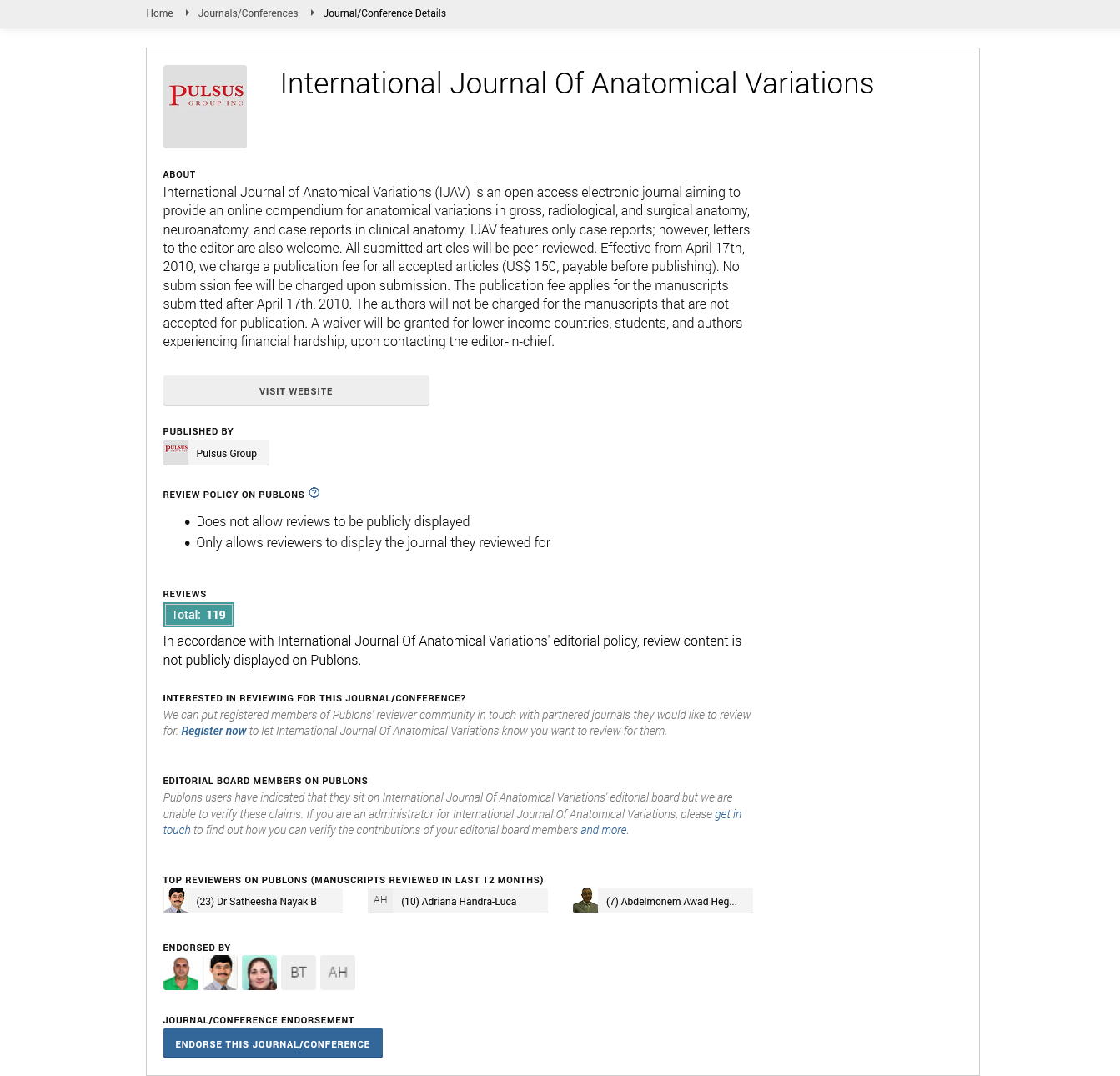Perforating Veins of the Lower Limb: Anatomical Variations and Their Impact on Chronic Venous Insufficiency
Received: 02-Jan-2025, Manuscript No. ijav-25-7546; Editor assigned: 04-Jan-2025, Pre QC No. ijav-25-7546 (PQ); Reviewed: 18-Jan-2025 QC No. ijav-25-7546; Revised: 24-Jan-2025, Manuscript No. ijav-25-7546 (R); Published: 31-Jan-2025, DOI: 10.37532/1308-4038.18(1).478
Citation: Ivanova TB. Perforating Veins of the Lower Limb Anatomical Variations and Their Impact on Chronic Venous Insufficiency. Int J Anat Var. 2025;18(1): 725-726.
This open-access article is distributed under the terms of the Creative Commons Attribution Non-Commercial License (CC BY-NC) (http://creativecommons.org/licenses/by-nc/4.0/), which permits reuse, distribution and reproduction of the article, provided that the original work is properly cited and the reuse is restricted to noncommercial purposes. For commercial reuse, contact reprints@pulsus.com
INTRODUCTION
The Perforating veins are integral in the venous drainage of the lower limbs, connecting the superficial and deep venous systems. They help maintain proper circulation by facilitating the movement of blood from the skin and subcutaneous tissues to the deeper veins. However, anatomical variations in these veins, such as their number, size, and function, can have significant clinical implications. Such variations can contribute to chronic venous insufficiency (CVI), a condition that leads to pain, swelling, and skin changes due to poor venous return. Understanding these anatomical variations is crucial for both diagnosing venous conditions and planning effective treatments. This article explores the anatomical variations of perforating veins, their association with CVI, and the clinical approaches to managing venous disorders related to these variations [1].
ANATOMY AND FUNCTION OF PERFORATING VEINS
Perforating veins are located throughout the lower limb and connect the superficial venous system with the deep venous system. They traverse the deep fascia to connect veins such as the great saphenous and small saphenous veins with deeper structures like the femoral and popliteal veins. The perforating veins typically function as one-way valves, preventing blood from flowing backward into the superficial venous system. This ensures efficient venous return to the heart and helps maintain normal circulatory pressure. When these veins function properly, blood moves from the superficial veins to the deep veins, avoiding venous congestion. However, when these veins are subjected to abnormal pressure, or when the valves malfunction, blood may flow in the reverse direction, leading to venous reflux. This condition can result in varicosities, venous hypertension, and ultimately chronic venous insufficiency [2].
ANATOMICAL VARIATIONS OF PERFORATING VEINS
Anatomical variations in perforating veins are common and can have significant implications for venous health. These variations may include differences in the number of perforating veins, their size, and the location of their openings. The distribution of perforating veins varies significantly between individuals, and some areas of the leg, such as the calf or thigh, may have more perforators than others. This variability may affect the overall efficiency of venous return and contribute to the development of venous diseases. One notable variation is the size of perforating veins. Some individuals have larger perforators that are more prone to valve incompetence, which leads to venous reflux. Larger veins can accommodate more blood flow, increasing pressure on the venous system and further exacerbating reflux. Conversely, smaller perforating veins may not be as effective in redirecting blood flow to the deep venous system, resulting in increased venous pressure in the superficial veins. Another critical anatomical variation is the location of the perforating veins. In some individuals, perforating veins may be situated in atypical regions, which can disrupt normal venous return patterns and contribute to localize venous pooling. Furthermore, directional flow in perforating veins can vary, with some veins allowing retrograde blood flow, leading to venous reflux and venous insufficiency [3].
IMPACT OF ANATOMICAL VARIATIONS ON CHRONIC VENOUS INSUFFICIENCY
Chronic venous insufficiency (CVI) is a common condition that can result from abnormalities in the perforating veins. In individuals with anatomical variations that lead to larger perforating veins or additional veins, the risk of developing CVI increases. The larger veins allow more blood to flow through them, which can result in higher venous pressures, particularly when the valves become incompetent. This increases the likelihood of venous reflux, which contributes to symptoms such as varicose veins, edema, pain, and skin changes. Perforating vein variations can also lead to the development of varicose veins in specific areas of the lower limb. In regions with multiple perforating veins or veins of larger size, blood may pool in the superficial venous system, causing the veins to stretch and become tortuous. This pooling leads to venous stasis, which can further exacerbate the condition, causing discomfort and leading to skin ulceration in severe cases. In addition, multiple perforating veins in certain locations may increase the overall venous capacity, causing the superficial veins to become overloaded. This can result in chronic venous hypertension, a primary factor in the development of CVI. Conversely, absent or underdeveloped perforating veins in other areas can lead to insufficient drainage of blood from the superficial veins, leading to congestion and increased venous pressure [4].
CLINICAL IMPLICATIONS AND DIAGNOSIS
Understanding the anatomical variations of perforating veins is essential for the effective diagnosis and management of chronic venous insufficiency. Clinicians need to recognize these variations in order to tailor treatment plans and prevent complications during interventions. Imaging techniques such as duplex ultrasound are instrumental in diagnosing venous reflux and identifying the location and function of perforating veins. Duplex ultrasound can detect abnormal flow patterns, allowing clinicians to assess whether perforating veins are functioning correctly or if venous reflux is present. In addition, advanced imaging modalities like magnetic resonance venography (MRV) or computed tomography (CT) venography can provide detailed views of the venous anatomy and help map out the venous insufficiency. These techniques enable clinicians to identify the anatomical variations that might contribute to CVI, facilitating targeted treatment strategies [5].
TREATMENT AND MANAGEMENT STRATEGIES
Treatment for chronic venous insufficiency caused by perforating vein abnormalities often involves a combination of conservative and invasive approaches. Conservative treatments, such as the use of compression stockings, elevate pressure in the veins, which helps improve venous return and reduces symptoms such as swelling and pain. Patients are often advised to elevate their legs and incorporate regular exercise to enhance blood circulation and reduce venous pressure. For more severe cases of CVI, particularly those with significant varicosities or venous ulcers, invasive procedures may be required. Endovenous laser treatment (EVLT), sclerotherapy, and foam sclerotherapy are common treatments that help obliterate incompetent veins and redirect blood flow to healthy veins. Surgical interventions, such as ligation and stripping of affected veins, are sometimes necessary when less invasive treatments are ineffective. In cases where perforating veins are particularly large or involve significant venous reflux, surgical excision or ligation of the perforating veins may be performed to restore normal venous flow. This procedure is typically followed by compression therapy to help the veins heal and prevent recurrence of varicose veins. Additionally, advanced techniques like venous stenting may be employed in complex cases to manage venous hypertension and improve blood flow.
CONCLUSION
Anatomical variations in the perforating veins of the lower limb play a significant role in the development and progression of chronic venous insufficiency. Variations such as increased size, number, and malformation of perforating veins can lead to venous reflux, contributing to the symptoms and complications associated with CVI. Accurate diagnosis through advanced imaging techniques is essential for identifying these variations and tailoring effective treatment strategies. Conservative therapies such as compression stockings, combined with surgical interventions in more severe cases, can help manage symptoms and improve quality of life for individuals with CVI. Understanding these anatomical variations ensures that clinicians are better prepared to address the challenges associated with venous insufficiency.
REFERENCES
- Fontana F, Coppola A, Ferrario L. Internal Iliac Artery Embolization within EVAR Procedure: Safety, Feasibility, and Outcome. J Clin Med. 2022; 11(24):73-99.
- Bleich AT, Rahn DD, Wieslander CK, Wai CY, Roshanravan SM, et al. Posterior division of the internal iliac artery: Anatomic variations and clinical applications. Am J Obstet Gynecol. 2007; 197:658.e651-658.e655.
- Rayt HS, Bown MJ, Lambert KV. Buttock claudication and erectile dysfunction after internal iliac artery embolization in patients prior to endovascular aortic aneurysm repair. Cardiovasc Intervent Radiol. 2008; 31(4):728-34.
- Chase J. Variation in the Branching Pattern of the Internal Iliac Artery. In: University of North Texas Health Science Center. Fort Worth. 2016: 1-33.
- Nayak SB, Shetty P, Surendran S, Shetty SD. Duplication of Inferior Gluteal Artery and Course of Superior Gluteal Artery Through the Lumbosacral Trunk. OJHAS. 2017; 16.
Indexed at, Google Scholar, Crossref
Indexed at, Google Scholar, Crossref
Indexed at, Google Scholar, Crossref






